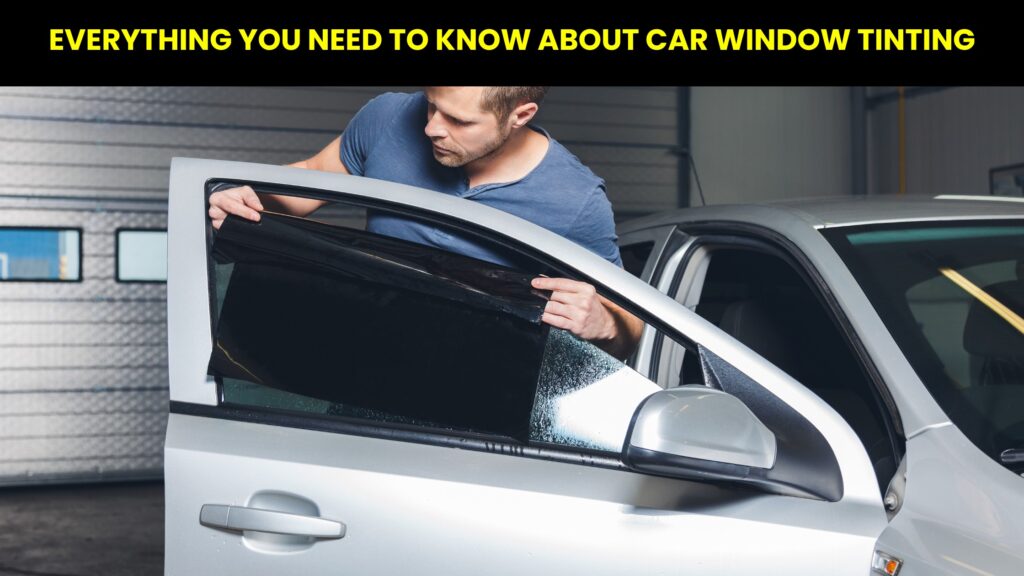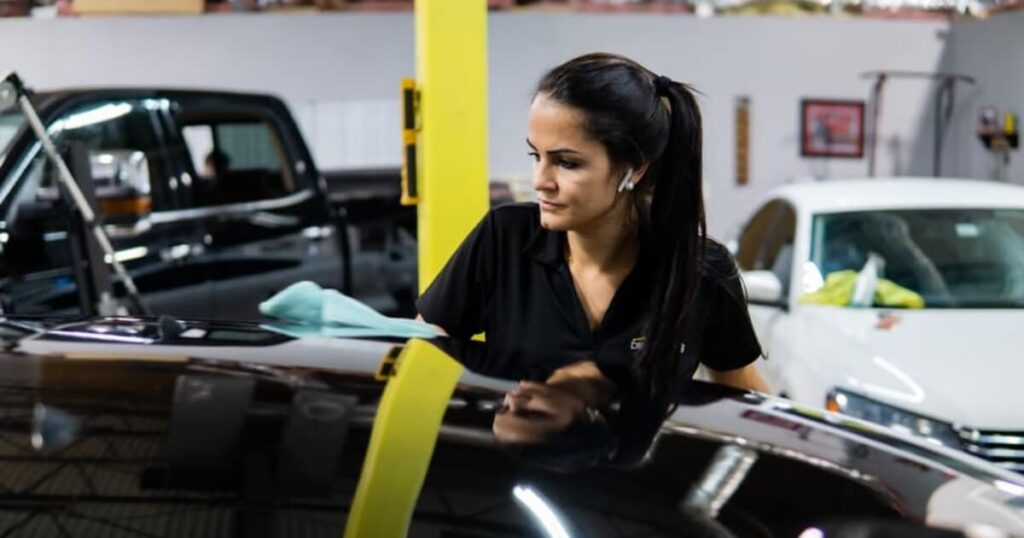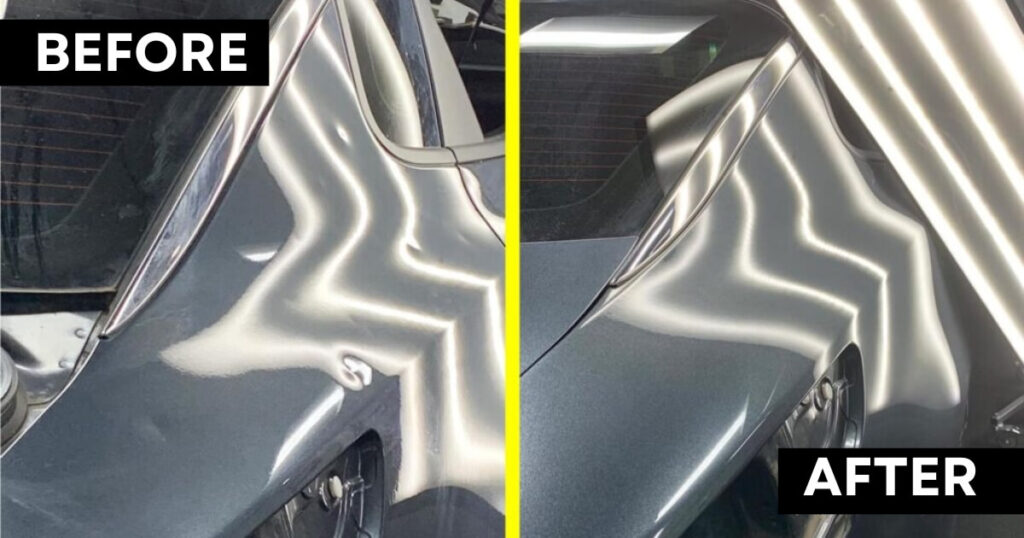Car window tinting is a prevalent vehicle modification that can provide many benefits. Tinted windows not only improve the look of your car but also protect you and your interior from heat and UV rays.
In this comprehensive guide, we’ll cover all aspects of car window tinting so you can decide if it’s right for your vehicle. You’ll learn about the different types of window films, what percentage of tint to choose, legal requirements, costs, pros and cons, and more. By the end, you’ll have all the information you need to make an informed decision about tinting your car windows.
What Is Window Tint?
Window tint refers to special films applied to a vehicle’s interior glass surfaces. These tint films are made of thin layers of metal particles embedded in a ceramic or dyed plastic substrate.
When installed correctly on the inside of windows, tint films prevent a significant amount of light, heat, and UV radiation from entering the car. There are several different types of tint materials used in automotive window films:
- Dyed (non-reflective) tint – This economical tint incorporates a dye into the plastic layer to absorb light. It offers an essential reduction of glare, heat, and UV rays.
- Carbon tint – Tiny carbon particles are used in the film to block radiation. This provides better heat and glare reduction than dyed films.
- Ceramic tint – A technologically advanced film constructed using nano-ceramic particles. Ceramic films provide the highest levels of heat rejection and UV blocking.
- Metalized tint -Thin layers of actual metal (usually aluminum) reflect light. Metalized films offer the darkest tint but are prone to interference and reduced radio reception.
The percentage of visible light transmission blocked by the film determines the level of visible tinting. Darker tints block more light from passing through.
Tint materials also differ in terms of total solar energy rejection (TSER) percentage, which measures the amount of infrared light and heat deflected. The higher the TSER, the cooler your car’s interior will remain.
What Are the Benefits of Vehicle Window Tint?
There are many excellent reasons motorists choose to have window tint professionally installed in their cars, trucks, SUVs, and other vehicles:
- Reduced Glare – Tinted windows significantly decrease glare and eye strain caused by intense sunlight. Anti-glare properties make it easier to see out the windshield on very bright days.
- Protection From UV Rays – Harmful ultraviolet radiation from the sun cannot penetrate quality tint films. UV rays are blocked before they reach passengers. This protects skin and eyes from exposure.
- Enhanced Privacy – Darker tint provides increased privacy and security. Thieves are not able to look inside your car and see valuables that may be tempting targets for smashing and grabbing.
- Thermal Insulation – Heat is significant source of discomfort in vehicles. Window tinting provides a thermal barrier that keeps interior cabin temperatures cooler. This also helps reduce air conditioning costs.
- Prevention of Sun Damage – Fabrics, dashboards, and interior trim fade and crack over time from sun exposure. Tint protects these surfaces and keeps interiors looking pristine.
- Improved Safety – Car window tint holds shattered glass together in the event of an accident or glass breakage. This helps prevent injuries from flying shards.
- Aesthetic Enhancement – Lastly, tinted windows simply give your car a classier, more stylish look. Vehicles appear much more sleek and modern with the darkened privacy glass.
With all these car window tinting benefits, it’s no wonder tinted windows are so popular among drivers seeking improved comfort, protection, and appearance.
Car Tinting Installation Options and Cost
You have a few options when it comes to getting your vehicle’s windows tinted. Professional installation from an experienced window tint shop is usually the best route for optimal performance and results.
Car Dealership Add-On – Some dealers now offer window tinting as an optional upgrade when you purchase a new or used vehicle. Although convenient, dealership add-on prices are typically inflated.
Tint Shop Installation – For the best quality tint films and installation, independent auto accessory shops that specialize in window tinting are often the best bet. They offer a range of film options with guaranteed lifetime warranties.
Mobile Tinting Service – Reputable mobile tint installers can provide quality films and applications at your home or workplace. There is no need to drop off your vehicle. This is easier if they inspect their work closely.
DIY Tint Kits – Pre-cut do-it-yourself tint kits can save money but are very difficult for novices to apply well. The results are often full of bubbles and other imperfections.
Costs vary depending on shop rates in your local market and the specific car, truck, or SUV model. The vehicle year, make, model, and number of windows all factor into the price. Entire car window tinting averages $150 to $600+ for high-end ceramic films.
Different Kinds of Tint
Now that you understand why drivers get their windows tinted and the installation options, let’s examine the major types of automotive window films available.
Dyed (Non-Reflective) Tint
As explained above, dyed tint films are the most affordable option. They get their color from a thin layer of embedded dye between adhesive layers rather than tiny metal particles.
Pros
- Good basic UV protection
- Help reduce sun glare
- The least expensive film type
Cons
- Only fair heat rejection
- It fades faster than other films
- Less durable and shorter lifespan
Dyed non-reflective films come in shades from very light smoke tints to medium darkness levels. Because they do not contain metal particles, these films do not interfere with radio reception.
Carbon Tint
Carbon window tint utilizes an extremely thin layer of carbon nanoparticles rather than dyes or metals to block light and radiation.
Pros
- Better glare reduction and UV blocking versus dyed films
- Improved heat rejection over-dyed films
- Maintains radio reception
- More fade resistant than dyed tint
Cons
- It costs more than dyed films
- Less effective at blocking infrared rays than ceramic or metallic tints
- Carbon tints are available in medium to very dark gradients. They offer good performance for the price.
Ceramic Tint
Ceramic films represent the top of the line in window tint technology. This high-tech film construction results in the most heat rejection and UV protection available.
Pros
- Unmatched thermal performance for cooler interior temperatures
- Over 99% UV ray blocking
- Excel at preventing sun damage and fading
- Maintain high clarity for longer than other films
Cons
- Most expensive automotive window tint
- Dark shades can interfere with phone signals and radio reception
- Ceramic nanoparticles embedded in the tint give this film its superior ability to deflect infrared radiation. Ceramic tints are available in light smoke and illegal limo blackout shades.
Metalized (Reflective) Tint
Metalized window films contain a thin metal coating, usually aluminum, applied via vacuum deposition. This reflective layer blocks more light, glare, and radiation than dyed films.
Pros
- The aluminum layer offers increased heat rejection
- It provides very dark tint levels
- Better at blocking UV rays than dyed films
Cons
- Higher cost than dyed tint
- Interfere with radio reception and cell phone signals
- Prone to corrosion over time in some environments
Metalized tint films allow for extremely dark window tinting but sacrifice radio reception. This type of tint is best avoided.
Removing Window Tint Film
It’s not usually difficult to remove tint that is already installed on your car windows if needed. Here is an overview of window tint removal methods.
Reasons for Window Tint Removal
- There are a few common reasons motorists choose to take off existing window film:
- Tint has bubbled, peeled, cracked, or degraded over time
- Aftermarket tint was installed poorly, with edges lifting or scratches
- Tint is too dark for local laws or your preferences
- You want to return the leased vehicle to its original condition
- Need better cellular reception that tint is interfering with
Professional Removal
For the cleanest results without damage, consider paying an auto shop $50 to $150 per vehicle to strip off old window film. They use specialized tools and chemicals to protect the glass.
DIY Removal
With patience, you can remove tint at home using a heat gun, razor blades, and soapy water solution. Be extremely cautious not to crack or scratch the glass. Follow these steps for DIY window tint removal:
Steps to Removing Window Tint
- Thoroughly spray the window glass with soapy water solution. This lubricates the film.
- Use a heat gun to warm the film gently. Avoid heating any single area too long.
- Once warmed, carefully lift a film edge using a plastic putty knife. Slowly peel it back.
- Use a new razor blade to gently score the adhesive residue. Keep the blade flat to prevent it from digging into the glass.
- Spray more soapy water and scrape off any remaining adhesive with plastic scrapers.
- Repeat soaking, heating, and scraping until all tint film and residue are removed from the window.
- Finish by cleaning the glass thoroughly with glass cleaner or isopropyl alcohol.
This process requires time and diligence to avoid damaging the windows. Only attempt removal if you can work slowly and cautiously. Rushing the process often leads to deep scratches or cracked glass.
If you need help tackling tint removal yourself, hire a professional. They have the proper tools and expertise to remove old film and adhesive without damaging your vehicle.
Automobile Window Tinting Process
When you choose to have window tint installed by a professional shop, what exactly does the process entail? Here is a typical window tinting procedure:
- Consultation – You’ll discuss your needs and preferences, select the type of film, choose the tint darkness level, review local laws, and receive a price quote.
- Interior Cleaning – All windows will be thoroughly cleaned before installation. Any grime or residue could create air bubbles later.
- Cutting the Tint – Your pattern and film type are programmed into a plotter. This precision cutting machine custom cuts the tint for each window.
- Window Preparation – The surfaces are cleaned again, and the tint pieces are tested fit to each window before final installation.
- Tint Application – Installers use specialized squeegees to apply the film, starting from the center and working toward the edges to remove moisture and air.
- Finishing Touches – Excess tint around the windows is trimmed off, and edges are carefully inspected. Any remaining moisture or air pockets are eliminated.
- Curing Time – It takes a few days for the tint adhesive to heal and adhere tightly. Avoid rolling down windows during this time.
Quality shops work meticulously to deliver a flawless window tinting job that looks amazing and provides the intended benefits.
How Long Does Window Tint Installation Take?
If you are having your windows professionally tinted, how long should you expect the installation process to take? Here are some general time estimates:
- Small car or sedan – Approximately 1-2 hours
- Truck or midsize SUV – Around 2-3 hours
- Large truck or SUV – 3-4 hours
- Huge truck/SUV or luxury car – Up to 5 hours
These are just rough guidelines. The actual time depends on factors such as:
- Number of windows being tinted
- Shop workflow and technician speed
- Type of film used
- Window condition and preparation time
- Drying and finishing time
Reputable shops avoid rushing the installation to ensure optimal performance. Taking time with careful window preparation, precise film application, and edge trimming leads to great results.
You can wait while your windows are tinted, or some shops may advise you to drop off your vehicle for several hours. When scheduling an appointment, confirm the expected turnaround time.
The Best Window Tinting Service for Quick and Reliable Tint Installation
Choosing where to get your car windows tinted is a crucial decision. The shop you select will have a significant impact on the look, performance, and longevity you achieve.
Here are tips for picking the best auto window tinting shop:
Check reviews – Read lots of customer feedback about their experiences. Look for consistent 5-star ratings.
- Verify licensing and insurance – The shop should be registered with your state and fully insured.
- View their work – Ask to see examples of previous tint jobs. Check for bubbles, ripples, and edge lifting.
- Ask about warranties – The best shops offer lifetime warranties on film materials and workmanship.
- Consider vehicle specialty – Some shops excel at certain automobile types like luxury cars or large trucks.
- Get price quotes – Reputable shops will provide firm price estimates in writing after inspecting your specific vehicle.
- Evaluate experience – Find out how many years they have been tinting windows. Longevity indicates quality services.
Choosing your tint shop carefully is a wise investment that will ensure you are delighted with the results. Darkened windows should enhance the look of your vehicle, not detract from it.
Conclusion
We’ve covered everything you need to know about getting your car windows tinted, from the types of films available and the percentage of tint to your state’s legal requirements and cost considerations.
Window tinting improves comfort through reduced heat and glare, protects from UV rays, and gives your vehicle an excellent, sleek appearance. With professional installation from a quality auto shop like Dentwerks, you can enjoy the many benefits tinted windows offer while avoiding problems from bubbles, scratched glass, or peeling edges. Use the guidance in this article to make informed decisions about darkening your car windows.



